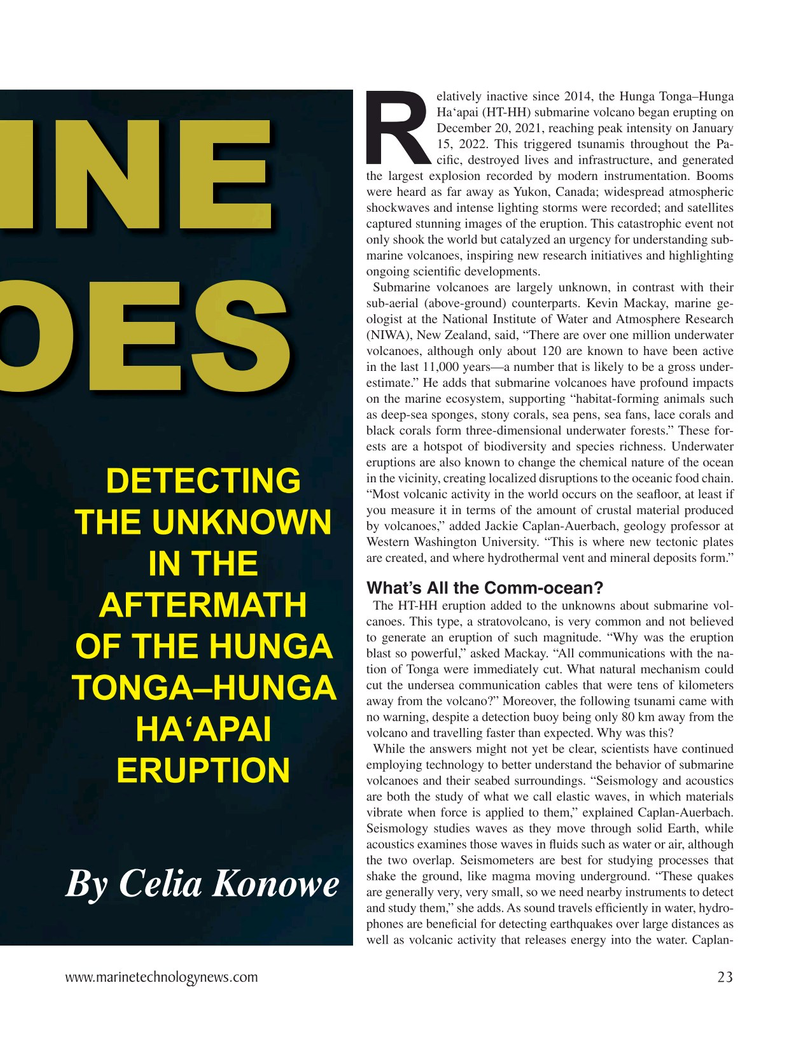
Page 23: of Marine Technology Magazine (March 2024)
Read this page in Pdf, Flash or Html5 edition of March 2024 Marine Technology Magazine
elatively inactive since 2014, the Hunga Tonga–Hunga
Ha‘apai (HT-HH) submarine volcano began erupting on
December 20, 2021, reaching peak intensity on January 15, 2022. This triggered tsunamis throughout the Pa-
R ci? c, destroyed lives and infrastructure, and generated the largest explosion recorded by modern instrumentation. Booms were heard as far away as Yukon, Canada; widespread atmospheric shockwaves and intense lighting storms were recorded; and satellites captured stunning images of the eruption. This catastrophic event not only shook the world but catalyzed an urgency for understanding sub- marine volcanoes, inspiring new research initiatives and highlighting ongoing scienti? c developments.
Submarine volcanoes are largely unknown, in contrast with their sub-aerial (above-ground) counterparts. Kevin Mackay, marine ge- ologist at the National Institute of Water and Atmosphere Research (NIWA), New Zealand, said, “There are over one million underwater volcanoes, although only about 120 are known to have been active in the last 11,000 years—a number that is likely to be a gross under- estimate.” He adds that submarine volcanoes have profound impacts on the marine ecosystem, supporting “habitat-forming animals such as deep-sea sponges, stony corals, sea pens, sea fans, lace corals and black corals form three-dimensional underwater forests.” These for- ests are a hotspot of biodiversity and species richness. Underwater eruptions are also known to change the chemical nature of the ocean in the vicinity, creating localized disruptions to the oceanic food chain.
DETECTING “Most volcanic activity in the world occurs on the sea? oor, at least if you measure it in terms of the amount of crustal material produced by volcanoes,” added Jackie Caplan-Auerbach, geology professor at
THE UNKNOWN
Western Washington University. “This is where new tectonic plates are created, and where hydrothermal vent and mineral deposits form.”
IN THE
What’s All the Comm-ocean?
The HT-HH eruption added to the unknowns about submarine vol-
AFTERMATH canoes. This type, a stratovolcano, is very common and not believed to generate an eruption of such magnitude. “Why was the eruption blast so powerful,” asked Mackay. “All communications with the na-
OF THE HUNGA tion of Tonga were immediately cut. What natural mechanism could cut the undersea communication cables that were tens of kilometers
TONGA–HUNGA away from the volcano?” Moreover, the following tsunami came with no warning, despite a detection buoy being only 80 km away from the volcano and travelling faster than expected. Why was this?
HA‘APAI
While the answers might not yet be clear, scientists have continued employing technology to better understand the behavior of submarine
ERUPTION volcanoes and their seabed surroundings. “Seismology and acoustics are both the study of what we call elastic waves, in which materials vibrate when force is applied to them,” explained Caplan-Auerbach.
Seismology studies waves as they move through solid Earth, while acoustics examines those waves in ? uids such as water or air, although the two overlap. Seismometers are best for studying processes that shake the ground, like magma moving underground. “These quakes are generally very, very small, so we need nearby instruments to detect
By Celia Konowe and study them,” she adds. As sound travels ef? ciently in water, hydro- phones are bene? cial for detecting earthquakes over large distances as well as volcanic activity that releases energy into the water. Caplan- www.marinetechnologynews.com 23
MTR #3 (18-33).indd 23 4/4/2024 9:08:25 AM

 22
22

 24
24
